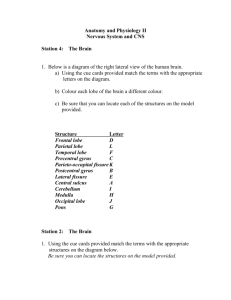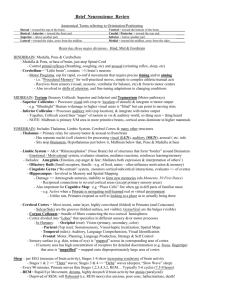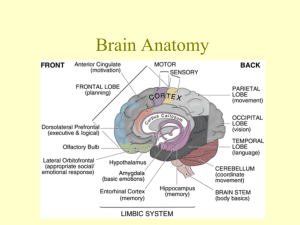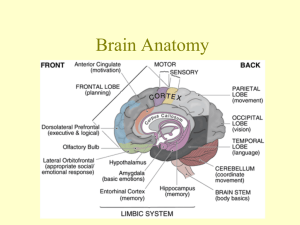Brain & Cranial Nerves
advertisement
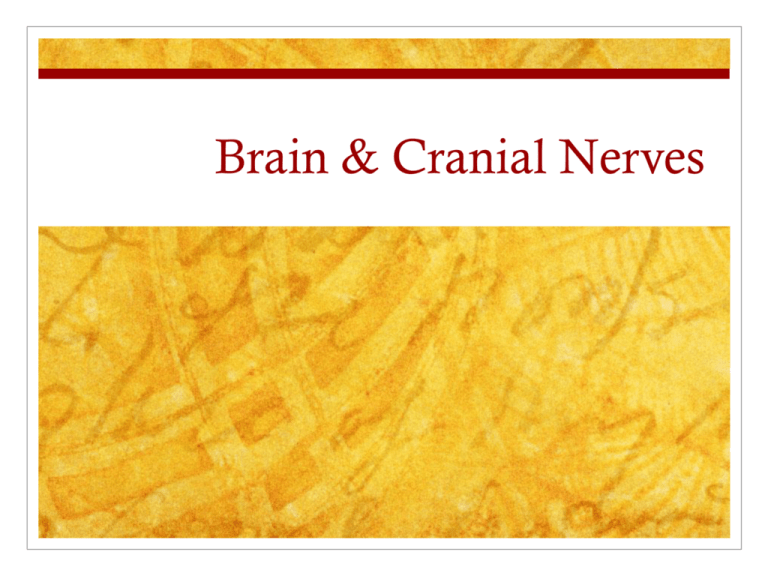
Brain & Cranial Nerves The Brain Ranges from 750 cc to 2100 cc Contains almost 98% of the body’s neural tissue Average weight about 1.4 kg (3 lb) 6 Major Regions of the Brain Cerebrum Cerebellum Diencephalon Mesencephalon Pons Medulla oblongata The Brain Cerebrum Largest part of brain Controls higher mental functions Divided into left and right cerebral hemispheres Surface layer of gray matter (neural cortex) Cerebral Cortex 3 Functional Principles of the Cerebrum 1. Each cerebral hemisphere receives sensory information from, and sends motor commands to, the opposite side of body 3 Functional Principles of the Cerebrum 2. The 2 hemispheres have different functions although their structures are alike 3 Functional Principles of the Cerebrum 3. Correspondence between a specific function and a specific region of cerebral cortex is not precise Motor & Sensory Areas of the Cerebral Cortex Where are the motor, sensory, and association areas of the cerebral cortex, and what are their functions? Central sulcus separates motor and sensory areas Motor Areas Precentral gyrus of frontal lobe: directs voluntary movements Primary motor cortex: is the surface of precentral gyrus Pyramidal cells: are neurons of primary motor cortex Sensory Area Postcentral gyrus of parietal lobe: receives somatic sensory information (touch, pressure, pain, vibration, taste, and temperature) Primary sensory cortex: surface of postcentral gyrus Special Sensory Cortexes Visual cortex: information from sight receptors Auditory cortex: information from sound receptors Olfactory cortex: information from odor receptors Gustatory cortex: information from taste receptors Sensory Association Areas Somatic sensory association area: interprets input to primary sensory cortex (e.g., recognizes and responds to touch) Visual association area: interprets activity in visual cortex Auditory association area: monitors auditory cortex Other Integrative Areas Speech center: is associated with general interpretive area coordinates all vocalization functions Prefrontal cortex of frontal lobe: integrates information from sensory association areas performs abstract intellectual activities (e.g., predicting consequences of actions) Hemispheric Lateralization Functional differences between left and right hemispheres Each cerebral hemisphere performs certain functions not performed by the opposite hemisphere The Left Hemisphere In most people, left brain (dominant hemisphere) controls: reading, writing, and math decision-making speech and language The Right Hemisphere Right cerebral hemisphere relates to: senses (touch, smell, sight, taste, feel) recognition (faces, voice inflections) Cerebellum Second largest part of brain Coordinates repetitive body movements 2 hemispheres Covered with cerebellar cortex The Cerebellum An autonomic processing center Functions of the Cerebellum 1. Adjusts postural muscles 2. Fine-tunes conscious and subconscious movements Structures of the Cerebellum Structures of the Cerebellum Folia: surface of cerebellum highly folded neural cortex Anterior and posterior lobes: separated by primary fissure Structures of the Cerebellum Cerebellar hemispheres: separated at midline by vermis Vermis: narrow band of cortex Flocculonodular lobe: below fourth ventricle Purkinje Cells Large, branched cells Found in cerebellar cortex Receive input from up to 200,000 synapses Arbor vitae Highly branched, internal white matter of cerebellum Cerebellar nuclei: embedded in arbor vitae relay information to Purkinje cells The Peduncles Tracts link cerebellum with brain stem, cerebrum, and spinal cord: superior cerebellar peduncles middle cerebellar peduncles inferior cerebellar peduncles Diencephalon Composed of Epithalmus Hypothalamus thalamus The Thalamus Final relay point for ascending sensory information Coordinates the activities of the cerebral cortex Hypothalamus Controls somatic motor activities subconsciously Controls autonomic function Rage, pleasure, pain, & sexual arousal Regulate heart rate, blood pressure, respiration, & digestive function Coordinates activities of the nervous and endocrine systems Inhibits or stimulates endocrine cells in the pituitary gland Hypothalmus cont. Secrete 2 hormones Antidiuretic hormone – restricts water loss at the kidneys Oxytocin –stimulates smooth muscle contractions Uterus/mammary glands Prostrate gland Produce emotions & behavioral drives Feeding center, thirst center Hypothalmus cont. Coordinate voluntary & autonomic functions Think about a dangerous situation Regulates body temperature Heart rate increases, respiratory rate goes up If temp. falls instructions sent to medulla oblongata to dialate blood vessels Controls Circadian rhythms 24 hour, day-night cycle Retina of the eye Medulla Oblongata Connects brain and spinal cord The Pons Sensory & motor nuclei for 4 cranial nerves Nuclei that help control respiration Nuclei & tracts linking the cerebellum with the brain stem, cerebrum, and spinal cord Ascending, descending & transverse tracts Cranial Nerves I – olfactory nerves – sensory II – optic nerves – sensory Visual information III – oculomotor – motor Sense of smell Motor eye movements IV – Trochlear Nerves – motor Superior oblique muscle Cranial Nerves V - Trigeminal Nerves - mixed, sensory VI - Abducen Nerves - motor Motor – jaw, mastication, eyelid, eyebrow, lips, gums. teeth, cheek Sensory – forehead, palate, nasal cavity Motor eye movement, lateral rectus VII - Facial – mixed Sensory – anterior 2/3 of tongue Motor – lacrimal gland, nasal mucous gland, submandibular & sublingual salivary glands Cranial Nerves VIII – Vestibulocochlear Nerves - sensory Special sensory – balance & equilibrium, hearing IX – Glossopharyngeal – mixed Sensory – posterior 1/3 of tongue, part of the pharynx & palate, carotid arteries Motor – pharyngeal muscles, parotid salivary gland Cranial Nerves X – Vagus – mixed XI – Accessory Nerves - motor Sensory – pharynx, diaphragm, Motor – pharyngeal muscles, visceral organs in thorax & abdominal cavity Muscles of neck & upper back XII – Hypoglossal Nerves – motor Tongue movement
